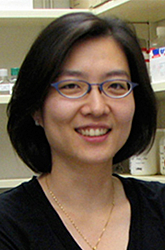You are here: Home > Unit on Developmental Neurogenetics
Molecular Genetics of Neural Stem Cells

- Sohyun Ahn, PhD, Head, Unit on Developmental Neurogenetics
- Cheol Lee, PhD, Visiting Fellow
- Sherry Ralls, BA, Technician Biologist
- Anna Kane, BS, Predoctoral Intramural Research Training Award Fellow
- Garrett Cheung, BS, Postbaccalaureate Intramural Research Training Award Fellow
Neural stem cells (NSCs) in the brain reside in specialized microenvironments called niches and produce new neurons throughout the life of an animal. Our overall goal is to understand how the NSCs are established during development and maintained after birth. Using the mouse as a model system, we study the interaction between NSCs and other cells within the neurogenic niche. Combining the power of genetics with other in vivo manipulation techniques, we are currently investigating the nature of regulatory signals presented by other cells in the niche, signals that dictate the behavior of NSCs. Insights gained from these studies should allow the development of cell type–specific strategies for the recruitment of endogenous NSCs during regeneration or for treatment of disease.
Establishment of the postnatal neurogenic niche
Sonic hedgehog (Shh) promotes proliferation of neural stem cells (NSCs) in the adult brain. However, Shh signaling does not act on NSCs until the late gestational stages, suggesting that proliferation of embryonic NSCs (= radial glia cells) and postnatal NSCs are regulated differently. Furthermore, the postnatal neurogenic niche contains various cell types such as ependymal cells that are also derived from embryonic NSCs around birth. Yet, how the distinct niche cell types are specified remains unclear. To better understand the molecular regulatory mechanism of Shh signaling, we focused on the Gli family of transcription factors (Gli1, Gli2, and Gli3), which are activated or modified in response to Shh activity. In particular, Gli3 is processed into a repressor form (Gli3R) in the absence of Shh signal and acts as the major negative transducer of the pathway. We investigated the role of Gli3 as a repressor in two systems in which Shh activity is lacking: the developing dorsal forebrain and embryonic NSCs. Our findings demonstrate the novel role of Gli3R in regulating neural stem/progenitors in the developing brain and in the postnatal neurogenic niche.
Around the time of birth, embryonic radial glia give rise to postnatal NSCs and ependymal cells, which constitute the neurogenic niche in the subventricular zone (SVZ) of the lateral ventricle in the mouse forebrain. Given that Shh–positive signaling begins around this transition, we addressed the role of the Gli3 repressor, in the absence of Shh signaling, in shaping this postnatal neurogenic niche. Our conditional genetic deletion approaches demonstrated that the Gli3 repressor is critical for specifying postnatal ependymal cells and NSCs. First, the Gli3 repressor is required to suppress gp130/STAT3 signaling at the transcriptional level to regulate the amount of GFAP¬–expressing glia cells in the SVZ. Next, the Gli3 repressor is required to maintain the appropriate amount of Numb protein via LNX ubiquitin ligase. Loss of Numb led to disruption in cell adhesion between ependymal cells and NSCs, resulting in compromised neurogenic activity of neighboring NSCs. Taken together, we provide a novel mechanism for the establishment of the SVZ niche structure and neurogenesis through an interplay between NSCs and environment.
Publications
- Wang H, Kane A, Lee C, Ahn S. Gli3 repressor controls cell fates and cell adhesion for proper establishments of neurogenic niche. (2014) Cell Reports 8(4): 1093-104.
- Cheng Y, Rodriguiz RM, Murthy SRK, Senatorov V, Thouennon E, Cawley NX, Aryal DK, Ahn S, Lecka-Czernik B, Wetsel WC, Loh YP. Neurotrophic factor-z1 prevents stress-induced depression through enhancement of neurogenesis and is activated by rosiglitazone. (2014) Molecular Psychiatry doi:10.1038/mp.2014.136.
- Mierzwa AJ, Sullivan GM, Beer LA, Ahn S, Armstrong RC. Comparison of cortical and white matter traumatic brain injury models reveal differential effects in the subvenricular zone and divergent Sonic hedgehog signaling pathways in neuroblasts and oligodendrocyte progenitors. (2014) ASN Neuro 6:1-16.
- Hayes L, Ralls S, Wang H, Ahn S. Duration of Shh signaling contributes to mDA neuron diversity. (2013) Dev Biol 374:115-126.
- Lee C, Hu J, Ralls S, Kitamura T, Loh YP, Yang Y, Mukouyama Y, Ahn S. The molecular profiles of neural stem cell niche in the adult subventricular zone. (2012) PLoS One 7:e50501.
Collaborators
- Regina Armstrong, PhD, Uniformed Services University of the Health Service, Bethesda, MD
- Hwai-Jong Cheng, MD, PhD, University of California, Davis, CA
- Y.P. Loh, PhD, Program in Developmental Neuroscience, NICHD, Bethesda, MD

